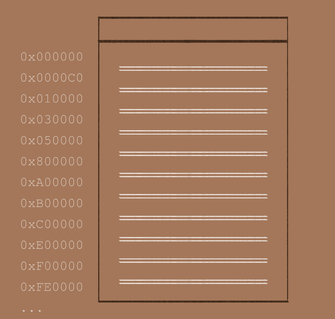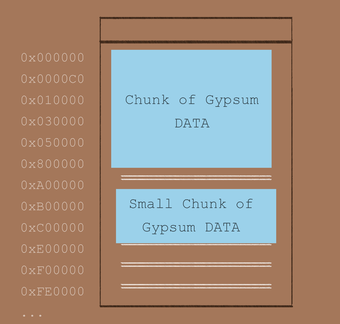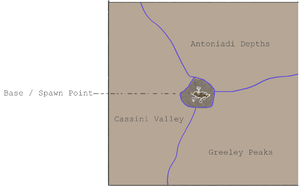Project Storm:Game Design: Difference between revisions
(Created page with " == Map == thumb == Loop == * Explore the Next Area * Find DATA *") |
No edit summary |
||
| (7 intermediate revisions by the same user not shown) | |||
| Line 1: | Line 1: | ||
This design pitch serves to establish the "meat" of the game. While there are additional segments planned (such as an intro tutorial sequence, and an epilogue), those elements are largely independent of each other and may be cut depending on time constraints. | |||
== | == Premise == | ||
The Opportunity Rover (also known as "Oppy") finds herself caught in a dangerous Martian storm. She is cut off from any contact with NASA. She finds a small temporary shelter, but due to a critical malfunction, she cannot engage her regular reboot functions. She is running out of battery, but if she turns herself off, she will be unable to turn herself on again. | |||
In order to restore proper functionality to her reboot functions, she needs root access to her core system components, which are normally only accessible by engineers at NASA. An unorthodox solution may exist in the form of a self-induced buffer overflow attack. | |||
* | Oppy has 128 megabytes of RAM and 256 megabytes of flash memory. If Oppy can overpopulate her RAM, she may be able to bypass her system security and access her core system components. If she can do that, she may be able to restore her reboot functionality and survive the oncoming storm. | ||
* | |||
* | <sup>No I have no idea what any of this means.</sup> | ||
== Goal == | |||
<blockquote>Main Mission: Collect 256 MB of data before the storm gets too severe.</blockquote>To induce a buffer overflow attack, the player must store more than 128 megabytes of data into Oppy's volatile memory (RAM) at once. Oppy will need to induce ''two'' total buffer overflow attacks in order to access her core system components, so Oppy will need to collect '''256''' '''MB''' of data in total (the total size of her flash memory). | |||
The player can collect data in the following ways: | |||
* '''Traversal''': travelling the map will automatically populate a ''small'' amount of data into Oppy's RAM. | |||
* '''Gypsum Ores''': scanning gypsum will populate a ''medium'' amount of data into Oppy's RAM. The amount of data depends on the size of the ore. | |||
* '''Radio Signals''': finding lost signals will populate a ''large'' amount of data into Oppy's RAM. | |||
The amount of data gathered by type will vary depending on the run, but the player should generally expect the following ratios: | |||
* 10% of total data will come from Traversal | |||
* 60% of total data will come from Gypsum Ores | |||
* 30% of total data will come from Radio Signal | |||
== Collecting Data == | |||
When collecting data, Oppy first stores it into her RAM, which must then be transferred to her flash memory. The transfer process leaves Oppy vulnerable, so she must be in a safe spot (i.e. the Spawn Point) before initiating it. Therefore, the player can only store up to '''128 MB''' of data at once before returning to base. | |||
[[File:Memory.png|335x335px|Diagram showing Oppy's RAM. At the start of the game, this will be empty.|center|alt=Diagram showing Oppy's RAM. At the start of the game, this will be empty.|thumb]] | |||
[[File:Memory 2.png|center|thumb|340x340px|After collecting data, Oppy's RAM becomes populated. She can only store up to 128 MB of data into her RAM at once.]] | |||
=== Corrupt Memory === | |||
Certain memory addresses are '''corrupt'''. When Oppy populates these addresses, some of Oppy's systems will start to malfunction. | |||
{| class="wikitable" | |||
|+ | |||
!Malfunction | |||
!Trigger | |||
!Effect | |||
|- | |||
|Amnesia | |||
|20% RAM populated. | |||
|Oppy will seemingly "teleport" to a nearby location at random times. | |||
|- | |||
|Memory | |||
|40% RAM populated. | |||
|Obstacles from Oppy's past will spawn into the world, sometimes obstructing her path. | |||
|- | |||
|Glitches | |||
|60% RAM populated. | |||
|Visual glitches will spawn in the world and replace geometry, acting like bottemless pits. | |||
|- | |||
|Physics | |||
|80% RAM populated. | |||
|Oppy's internal and visual physics calculations will malfunction, resulting in player control abnormalities (such as changes to the friction values), as well as visual artifacts like floating rocks. | |||
|} | |||
The malfunctions will automatically be cured when Oppy depopulates her RAM and transfers her data into flash memory (which can be done only after returning to base). | |||
== Progression and Traversal == | |||
[[File:Map oppy.png|thumb|A rudimentary sketch of the map. The player must return to the center point after visiting one of the three outer areas.]]Players will spawn in an open area and have the freedom to decide which direction they want to go. | |||
The map contains four main elements: three explorable areas, and the center base that the player must return to between areas. Each area is distinct in visuals and have varying types of traversal obstacles. | |||
Once the player exits one of the three explorable areas, they will be '''unable to return to that area'''. It will disappear from existence, as a result of Oppy's failing functionality. | |||
=== Storm Progression === | |||
The storm progression is dependent on traversal. After the player enters and exits one of the three areas, the storm's intensity will increase. | |||
{| class="wikitable" | |||
|+ | |||
!Intensity Level | |||
!Effects | |||
|- | |||
|1 | |||
|Occasional dust devils spawn. | |||
|- | |||
|2 | |||
|Dust devils increase in frequency. Fog causes low visibility. High winds affect Oppy's movement. | |||
|- | |||
|3 | |||
|Visibility is decreased further. Wind and fog increase. Clumps of gravel is picked up by the wind and act as projectiles. | |||
|} | |||
=== Areas === | |||
There are three main areas to explore. | |||
* Cassini Valley: this area focuses on tight corridors, natural bridges, and unusual rock formation. | |||
* Greeley Peaks: this area focuses on tall rocks, steep cliffs, and hills. | |||
* Antoniadi Depths: this area focuses deep craters, low light, and tunnels. | |||
== Gameplay Loop == | |||
The main gameplay loop is as follows: | |||
# Enter one of the three main areas of the map. | |||
# Scan data, while navigating terrain and avoiding obstacles due to malfunctions and the storm. | |||
# Avoid death and return to base. | |||
# Transfer data from RAM to flash memory. | |||
The main things working against the player are Oppy's malfunctions and the Storm progression. The more data Oppy has in RAM, the more difficult the game becomes. But if the player doesn't scan enough data, they will not be able to achieve the 256 MB by the end of the run. At the same time, the player should try to get as much data as possible early on, as the storm intensity will increase over time. | |||
As the player can only hold 128MB of data at once, the player must repeat this loop at least twice. However, the vast majority of players will do so three times. | |||
Latest revision as of 01:28, 4 January 2024
This design pitch serves to establish the "meat" of the game. While there are additional segments planned (such as an intro tutorial sequence, and an epilogue), those elements are largely independent of each other and may be cut depending on time constraints.
Premise
The Opportunity Rover (also known as "Oppy") finds herself caught in a dangerous Martian storm. She is cut off from any contact with NASA. She finds a small temporary shelter, but due to a critical malfunction, she cannot engage her regular reboot functions. She is running out of battery, but if she turns herself off, she will be unable to turn herself on again.
In order to restore proper functionality to her reboot functions, she needs root access to her core system components, which are normally only accessible by engineers at NASA. An unorthodox solution may exist in the form of a self-induced buffer overflow attack.
Oppy has 128 megabytes of RAM and 256 megabytes of flash memory. If Oppy can overpopulate her RAM, she may be able to bypass her system security and access her core system components. If she can do that, she may be able to restore her reboot functionality and survive the oncoming storm.
No I have no idea what any of this means.
Goal
Main Mission: Collect 256 MB of data before the storm gets too severe.
To induce a buffer overflow attack, the player must store more than 128 megabytes of data into Oppy's volatile memory (RAM) at once. Oppy will need to induce two total buffer overflow attacks in order to access her core system components, so Oppy will need to collect 256 MB of data in total (the total size of her flash memory).
The player can collect data in the following ways:
- Traversal: travelling the map will automatically populate a small amount of data into Oppy's RAM.
- Gypsum Ores: scanning gypsum will populate a medium amount of data into Oppy's RAM. The amount of data depends on the size of the ore.
- Radio Signals: finding lost signals will populate a large amount of data into Oppy's RAM.
The amount of data gathered by type will vary depending on the run, but the player should generally expect the following ratios:
- 10% of total data will come from Traversal
- 60% of total data will come from Gypsum Ores
- 30% of total data will come from Radio Signal
Collecting Data
When collecting data, Oppy first stores it into her RAM, which must then be transferred to her flash memory. The transfer process leaves Oppy vulnerable, so she must be in a safe spot (i.e. the Spawn Point) before initiating it. Therefore, the player can only store up to 128 MB of data at once before returning to base.


Corrupt Memory
Certain memory addresses are corrupt. When Oppy populates these addresses, some of Oppy's systems will start to malfunction.
| Malfunction | Trigger | Effect |
|---|---|---|
| Amnesia | 20% RAM populated. | Oppy will seemingly "teleport" to a nearby location at random times. |
| Memory | 40% RAM populated. | Obstacles from Oppy's past will spawn into the world, sometimes obstructing her path. |
| Glitches | 60% RAM populated. | Visual glitches will spawn in the world and replace geometry, acting like bottemless pits. |
| Physics | 80% RAM populated. | Oppy's internal and visual physics calculations will malfunction, resulting in player control abnormalities (such as changes to the friction values), as well as visual artifacts like floating rocks. |
The malfunctions will automatically be cured when Oppy depopulates her RAM and transfers her data into flash memory (which can be done only after returning to base).
Progression and Traversal

Players will spawn in an open area and have the freedom to decide which direction they want to go.
The map contains four main elements: three explorable areas, and the center base that the player must return to between areas. Each area is distinct in visuals and have varying types of traversal obstacles.
Once the player exits one of the three explorable areas, they will be unable to return to that area. It will disappear from existence, as a result of Oppy's failing functionality.
Storm Progression
The storm progression is dependent on traversal. After the player enters and exits one of the three areas, the storm's intensity will increase.
| Intensity Level | Effects |
|---|---|
| 1 | Occasional dust devils spawn. |
| 2 | Dust devils increase in frequency. Fog causes low visibility. High winds affect Oppy's movement. |
| 3 | Visibility is decreased further. Wind and fog increase. Clumps of gravel is picked up by the wind and act as projectiles. |
Areas
There are three main areas to explore.
- Cassini Valley: this area focuses on tight corridors, natural bridges, and unusual rock formation.
- Greeley Peaks: this area focuses on tall rocks, steep cliffs, and hills.
- Antoniadi Depths: this area focuses deep craters, low light, and tunnels.
Gameplay Loop
The main gameplay loop is as follows:
- Enter one of the three main areas of the map.
- Scan data, while navigating terrain and avoiding obstacles due to malfunctions and the storm.
- Avoid death and return to base.
- Transfer data from RAM to flash memory.
The main things working against the player are Oppy's malfunctions and the Storm progression. The more data Oppy has in RAM, the more difficult the game becomes. But if the player doesn't scan enough data, they will not be able to achieve the 256 MB by the end of the run. At the same time, the player should try to get as much data as possible early on, as the storm intensity will increase over time.
As the player can only hold 128MB of data at once, the player must repeat this loop at least twice. However, the vast majority of players will do so three times.
